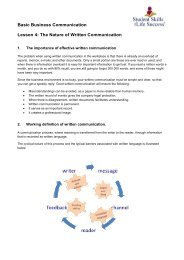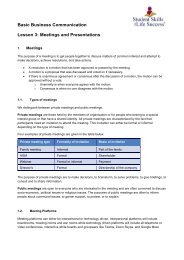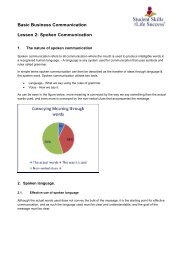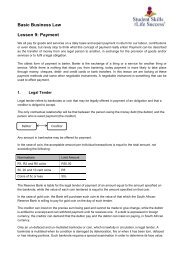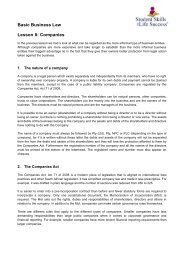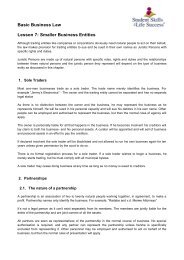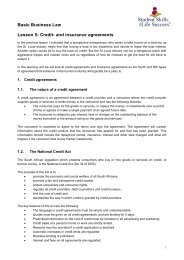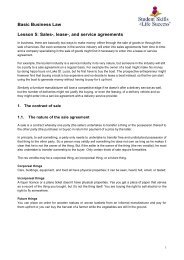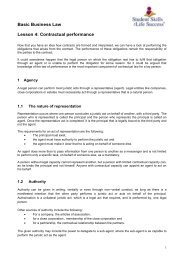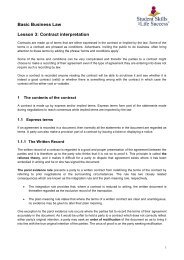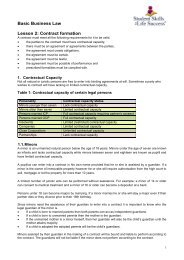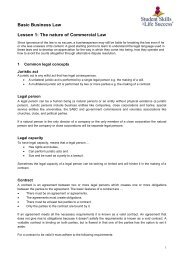Basic Business Communication. Lesson 1. Principles
This is the first lesson for Basic Business Communication. The following topics are covered in this lesson: 1. Communication in the workplace 2. The communication process 3. Communication categories 4. communication classes 5. Verbal and non-verbal communication. 6. Spoken and written communication 7. Visual non-verbal communication 8. Non-visual, non-verbal communication 9. Mixed and implied messages 10. Effective listening 11. Types of Listening 12. Communication barriers Video Links to this lesson https://youtu.be/PIAFiMwSdVk?si=a4zEltHXK0Rdk2w3 https://youtu.be/l8iKv1ixKSw?si=WNdKNTTkLuqp5C6Y
This is the first lesson for Basic Business Communication. The following topics are covered in this lesson:
1. Communication in the workplace
2. The communication process
3. Communication categories
4. communication classes
5. Verbal and non-verbal communication.
6. Spoken and written communication
7. Visual non-verbal communication
8. Non-visual, non-verbal communication
9. Mixed and implied messages
10. Effective listening
11. Types of Listening
12. Communication barriers
Video Links to this lesson
https://youtu.be/PIAFiMwSdVk?si=a4zEltHXK0Rdk2w3
https://youtu.be/l8iKv1ixKSw?si=WNdKNTTkLuqp5C6Y
- TAGS
- communication barriers
- effective listening
- implied messages
- proxemics
- emojis
- signs
- icons
- non verbal communication
- formal communication
- mass communication
- extra personal communication
- intrapersonal communication
- interpersonal communication
- feedback
- communication channel
- decoding
- encoding
- messages
- the receiver
- the sender
You also want an ePaper? Increase the reach of your titles
YUMPU automatically turns print PDFs into web optimized ePapers that Google loves.
<strong>Basic</strong> <strong>Business</strong> <strong>Communication</strong><br />
<strong>Lesson</strong> 1: <strong>Principles</strong> of Effective <strong>Business</strong> <strong>Communication</strong><br />
More time is spent on communication in the workplace than on any other activity, and the bulk of our<br />
communication is spent on listening to others. Figure 1 below illustrates the average time workers spent on<br />
different communication activities in the workplace.<br />
<strong>1.</strong> <strong>Communication</strong> in the workplace<br />
Since so much time is spent on communication in the workplace, it is clearly advantageous to be a good<br />
workplace communicator. Since the average adult only listens with 25% efficiency, you will have a distinct<br />
competitive advantage if you develop your listening skills.<br />
At the same time, the effects of bad workplace communication can be dire. As such, companies can simply<br />
not afford to employ bad communicators in any capacity. <strong>Business</strong> managers will only spent 30 to 120<br />
seconds to read a document, and so it is important to get to your point as soon as possible.
2. The communication process.<br />
While communication happens constantly and spontaneously, it can be described as an eight-step process,<br />
as illustrated below.<br />
2.<strong>1.</strong> The sender and the receiver.<br />
The person who initiates the communication is known as the sender, while the person, or persons, who<br />
receives the communication is known as the receiver. The receiver(s) is also known as the audience. In<br />
order for the communication to be successful, the sender must know its audience.
The audience can consist of 1 or more receivers. In a group, different people can act as both senders and<br />
receivers.<br />
2.2. The message and the channel.<br />
The message is the information that you want to give the receiver.<br />
• You want to be as accurate as possible.<br />
• You want the receiver to understand the message as you conceived it.<br />
The Channel as the way you send the message. You can use a verbal channel, that can either be spoken or<br />
written, or a non-verbal channel.<br />
• Verbal<br />
o<br />
o<br />
Written<br />
• Letter, Fax, Email, SMS, MMS, document, note, newspaper, magazine, road sign,<br />
notice, book etc.<br />
Spoken<br />
• Voice mail, telephone, radio, lecture, meeting, TV, conversation, interview etc.<br />
• Non-Verbal<br />
o Voice tone<br />
o Facial expression<br />
o Posture, etc.
3. <strong>Communication</strong> categories.<br />
When we communicate, our communication are not always directed at other individuals. Based on who the<br />
communication is directed at, we can distinguish between the following communication categories.<br />
4. <strong>Communication</strong> classes.<br />
<strong>Communication</strong> can either be formal or informal. You must know if the environment you are communicating<br />
in is formal or informal.<br />
• Register refers to the degree of formality you use to address a person or a group.<br />
• The degree of formality will depend on the organisation's structure and culture.<br />
Above is an example of a classical hierarchical company structure. The workers will address the CEO by<br />
title, and they will seldom have contact with him.
In a more modern hierarchy, everybody, including the CEO, is addressed by their name.<br />
Even in one organisation, there will be both formal and informal communication structures.<br />
5. Verbal and non-verbal communication.<br />
Verbal communication includes both spoken and written communication. Both verbal- and non-verbal<br />
communication can be visual or non-visual
6. Spoken and written verbal communication.<br />
Spoken communication in the workplace is used in all the following situations:<br />
• Meetings<br />
• Interviews<br />
• Client visits<br />
• Presentations<br />
• Brainstorming<br />
• Announcements over intercom<br />
• Telephone conversations.<br />
Typical uses of written communication in the workplace include the following:<br />
• Reports<br />
• Faxes<br />
• Notices<br />
• Memo’s<br />
• Press releases<br />
• Minutes of meetings<br />
• E mails<br />
• SMS/MMS<br />
7. Visual non-verbal communication.<br />
Four types of visual non-verbal communication that are commonly used in the workplace are listed below.<br />
7.<strong>1.</strong> Facial expressions, gestures, and posture<br />
• Frowning to indicate displeasure.<br />
• Pointing to identify someone.<br />
• Fiddling with keys can indicate nervousness.<br />
• Standing upright indicate confidence.<br />
• Sloping shoulders indicate disappointment.<br />
7.2. Icons<br />
We use icons in the computer environment on a daily basis.<br />
7.3. Signs<br />
Signs are used in the workplace so that even people who cannot read, or does not stand the language used<br />
there, will be able to follow the instructions.
7.4. Emoticons and emojis<br />
People started using emoticons to convey the writer’s emotions or clarify intent, by using a digital icon or a<br />
sequence of keyboard symbols that serves to represent a facial expression. For example, :‐) for a smiling<br />
face.<br />
Emoticons have been replaced by emojis over the last couple of years. An emoji is a small digital picture<br />
that represents a thing, feeling or concept, and that is used in text messages and other electronic<br />
communications. They normally form part of a standardized set for the application in use.<br />
Younger workers use emojis extensively in their communications, and any workplace manager will benefit<br />
from knowing there meaning and how to use them sparingly. Below is a screenshot from a number of<br />
smiley emojis that forms part of the WhatsApp set.<br />
8. Non-visual, non-verbal communication.<br />
Sound like that of an alarm, instrumental music and the tone of the speaker’s voice are examples of nonvisual,<br />
non-verbal communication. All these examples are reliant on the ears and not the eyes and exclude<br />
the use of language, but this type of communication can also refer to how close we allow different people to<br />
us and is called proxemics. Proxemics is strongly influenced by culture. Edward Hall is a scientist who<br />
studied proxemics and who can up with the proxemic zones below, as it applies to western cultures.
9. Mixed & Implied Messages<br />
It is important that you do not confuse your audience, and therefor the words and the images you use must<br />
not contradict each other. In the two examples below, it is clear that the words and the images do not go<br />
together.<br />
In these cases the express messages are in the callouts, but the implied message in the pictures says<br />
something completely different. Below are a couple of confusing traffic signs.
10. Effective Listening<br />
As already mentioned, we spend more time listening than on any other communication skill. It is therefor<br />
important to be an effective listener. Listening is a dynamic, cyclical process, but not necessarily sequential,<br />
as all the activities below can be happening at the same time.<br />
• Hearing: A passive activity, ignoring noise.<br />
• Filtering: The deliberate manipulation of the info.<br />
• Interpreting: To make sense of it and understand it.<br />
• Remembering: To recall or think about it again.<br />
You must listen in such a way that you will be able to respond effectively to the sender.<br />
1<strong>1.</strong> Types of listening<br />
We can distinguish between the following different types of listening as indicated in the figure below.
12. <strong>Communication</strong> Barriers<br />
We can identify the following communication barriers.<br />
• Physical barriers: for example, noise and distance.<br />
• Physiological barriers: for example, disabilities<br />
• Psychosocial barriers: for example, attitude and emotions<br />
• Perceptual barriers: for example, prejudices<br />
• Semantic barriers: for example, slang, jargon, and accent<br />
• Intercultural barriers: for example, Non-verbal greetings.<br />
• Reference Barriers: Cultural background, Attitudes, Emotions, Ego, IQ, Values, Beliefs, Status &<br />
Education.<br />
To communicate effectively we must remove these barriers.<br />
• Reduce the physical barriers.<br />
• Create a conducive environment.<br />
• Remove distractions.<br />
• Be willing and open to communicate.<br />
• Use clear and simple words, sentences.<br />
• Avoid jargon and slang.<br />
• Communicate face to face if you can.<br />
• Show trust in the messenger.<br />
• LISTEN





